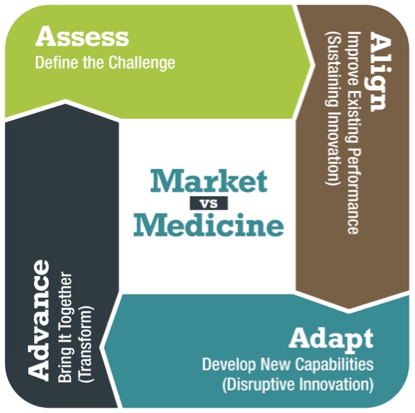August 30, 2016

Summer Book Report: 4sight Health’s Busy August
With Labor Day weekend approaching, state fairs in full swing, and the barbeque calling, most of us have just half a mind on work. At 4sight Health we’re enjoying the end of summer by celebrating two major milestones.
First Achievement of Note: Market vs. Medicine recently topped 1,000 copies sold. Woo Hoo! The potential of market-driven healthcare reforms is resonating. I’ve receive hundreds of reader comments regarding the book, speaking engagements and our weekly Market Corner commentaries. I and the rest of the 4sH team are incredibly grateful for everyone who believe, like we do, that America can achieve better healthcare at lower costs. Let’s keep our sights high and the pressure on.
Second Milestone: I’ve just contracted with the powerhouse Leigh Bureau to represent me in future speaking engagements. Expect a formal press release after Labor Day. It feels wonderful to get the backing of an organization that features such renowned healthcare thought leaders as Zeke Emanuel, Atul Gawande, Elliott Fisher and Don Berwick. With Leigh Bureau’s support, I aspire to become a clear and more influential advocate for health system transformation based on outcomes, efficiency, customer experience and behavioral change.
Here’s our summer book report. Like CliffsNotes (who was Cliff?), we’re using this week’s commentary to summarize MvM’s core themes. Here’s hoping some of you are reading this at the beach!
Have a great end of summer!

America’s health care system is neither healthy, caring, nor a system.-Walter Cronkite
There are more than 9,000 billing codes for individual procedures and units of care. But there is not a single billing code for patient adherence or improvement, or for helping patients stay well.-Clayton M. Christensen
Here’s the truth about U.S. healthcare.
It’s too expensive, too fragmented, too variable and asset-heavy. It’s over-invested in acute and specialty care and under-invested in prevention, primary care, behavioral health and chronic disease management. It makes too many mistakes and refuses to learn from them. It inhibits transparency, consumer choice, compassion and patient participation and decision-making. And as currently constituted, it exerts an enormous drag on the overall U.S. economy.
For decades, America has tried unsuccessfully to fix its broken healthcare system through government-led regulatory change. The current plight of the public exchanges exemplifies this struggle. Here’s the good news. This time it’s different. Purchasers, not providers, of healthcare are driving reform. The same American business practices that transformed manufacturing, distribution, communications and technology is taking aim at healthcare. It’s time for American healthcare consumers to win.

Bending Toward Value
Market vs. Medicine describes the process through which market-driven solutions are emerging to fix and transform U.S. healthcare. There are four stages which mirror the book’s four sections:
- Assess (Define the Problem): Explains the values, history and economics that have shaped U.S. healthcare and created a productivity paradox (too much investment delivering too much care, mediocre outcomes and spiraling costs);
- Align (Sustaining Innovation): Demonstrates how continuous performance improvement delivers better health outcomes at lower costs. Explains how consumers’ newfound market power normalizes supply and demand relationships;
- Adapt (Disruptive Innovation): Explores how disruptive population-health pricing models will promote care management and reduce unnecessary acute utilization. Expect more behavioral health, chronic disease management and health promotion. Incumbents, particularly academic health systems, will struggle to adapt;
- Advance (Transform): Explores the origins of America’s chronic disease epidemic. Recognizes that healthcare accounts for only 10 percent of health status. Acknowledges that lifestyle choices, genetics, environmental and socio-economic factors are far more influential. Appreciates that healthcare must expand beyond treatment to cultivate a wellness culture that gives all Americans the tools to lead healthier, more productive lives.
At 18% of GNP (50% more than any other advanced nation spends), there’s more than enough money to provide adequate or even superior healthcare service to everyone in the country. U.S. healthcare confronts a distribution, not a funding challenge. Well-regulated marketplaces are the most effective mechanisms for efficient resource allocation. It’s time to let them work their magic on healthcare.
Value is driving financial performance in post-reform healthcare. America’s unique ability to promote and fund innovation is turbocharging healthcare transformation. Promising companies attract investment capital. As consumers and employees demand greater value, more investment capital is flowing into companies delivering better, more affordable and more convenient healthcare services.
Every epic tale has a moral. To paraphrase Martin Luther King, “The arc of U.S. healthcare is long, but it bends toward value.” Hence, “Value Rules” is the moral of Market vs. Medicine’s heroic journey toward better healthcare for all Americans.

New Rules
The U.S. health system costs too much and delivers sub-par outcomes because it combines centralized reimbursement analytics with ferocious private-market pursuit of formulaic reimbursement payments. The activity-based, fee-for-service reimbursement system has conditioned providers to optimize revenues at the expense of customer value and the efficient use of labor, supplies and capital. It is a weapon of mass value destruction.
Even with reform, most health companies still employ a regulatory mindset where the managerial objective is to maximize revenues. Customer needs are secondary considerations. In contrast, companies like Apple, Amazon, Walmart, etc. sustain high levels of innovation and success by focusing on the customer and offering products that are desirable, affordable and accessible.
Imagine what all health companies – from providers and insurers to technology and device companies and solutions services – could achieve if they directed their considerable capabilities away from maximizing revenues and toward value .
Enlightened health companies are embracing value-based delivery to prosper in post-reform healthcare. The new playbook has the following five rules:
Rule #1. Quality is Job 1: Trying to overcome a planned-obsolescence managerial mindset and respond to voracious Japanese competition, Ford Motor Company launched its “Quality is Job 1” campaign in the early 1980s, transformed operations, started building great cars again and turned the company around. By definition, there can only be one “Job 1.” Health companies that don’t give quality primacy can never hit targeted quality, safety and outcomes metrics. Left unopposed, the energy generated from optimizing revenues (Job 1 at most health systems) overwhelms well-meaning quality initiatives. There is no wiggle room in pursuing quality.
Rule #2. Care Episodes, Not Treatment Codes: As more care becomes routine (episodic with high outcome certainty), customer assessment of quality shifts to price, convenience and customer experience. Most treatments, even surgical procedures, are increasingly routine and potentially vulnerable to commodity pricing from retail competitors. Piecemeal treatment activity is the principal revenue driver for hospitals and doctors. As delivery migrates toward value, entire patient-care episodes will emerge as the logical units of outcome measurement and payment. Providers will bundle all pre-acute, acute and post-acute activity into single cohesive treatment regimens that incorporate relevant clinical, operational and financial data. Reducing performance and pricing variation, particularly in post-acute care, will differentiate high-performing health systems.
Rule #3. Price Matters: Third-party reimbursement for treatment activity has protected health companies from traditional market forces governing supply and demand. Increasing transparency regarding treatment outcomes and prices is reshaping market dynamics. When reimbursement payments are higher than market prices for routine treatments, it creates opportunities for independent entities to disintermediate traditional relationships between patients and providers. Over time, market forces will drive payments for routine care to lower price points. Expect value-driven behavior to shape pricing and service delivery for insurance products, diagnostic procedures and routine treatments. Using programs like SmartShoppers, employers offer payment incentives to direct employees to lower-cost, high-quality treatment centers.
Rule #4: Data is as Data Does: Data informs decision-making when metrics and analytics support desired outcomes. Health companies have excellent data for measuring treatment volume, payment flow and revenue optimization. Unfortunately, they have not developed effective metrics and analytics for optimizing care management and outcomes. As big data evolves, precision searching of massive data sets informed by cutting-edge analytics will give external reviewers the ability to assess and rank health system performance. For better or worse, every healthcare provider and procedure will have a score. The race is on. Data must support quality and cost-effective delivery. Healthcare companies that advance value-based care delivery will develop enhanced data capabilities, earn external praise and gain market share.
Rule #5: It’s the Customer, Stupid! As the healthcare marketplace becomes more individualized, consumers will exercise more control over medical decision-making. Unleashed, consumers become value-seeking machines, rewarding companies that offer more selection, lower prices, greater convenience and better customer experience. Businesses only exist to serve customers. Beyond providing appropriate care, health companies must engage customers through individually tailored programs, shared medical decision-making and meaningful second opinions. Health companies that help customers navigate healthcare’s complex pathways will earn their loyalty. A good marketing campaign isn’t sufficient. Rhetoric and performance must align or valuable customers will seek care services elsewhere.
Incumbent healthcare companies are largely tone deaf to consumers’ needs. They execute transactions with limited patient involvement. Most healthcare executives don’t even like the word “customer.” Implicitly, they believe patients have little or no power. Power shifts when consumers make choices. Demand-driven change generates super-hero results.

Forward
Around the world, other advanced economies manage healthcare provision and control healthcare expenditures through centralized systems. U.S. healthcare has the ability to leapfrog these centralized health systems through innovation, value creation and customer-focused service delivery. As health companies deliver higher value, American healthcare will become both better and more affordable.
Value-based competitors are fighting for market share the American way—by delivering better services to customers at lower prices. They leap toward value, embrace customers and welcome competition. Here’s my advice to health company executives: Put customers first. Make quality Job 1. Resist easy short-term gains. Strive for long-term value.
It’s the right thing to do. It’s also the smart business strategy. Everybody wins when health companies deliver better care at lower prices in customer-friendly venues. Repeat to yourself: Outcomes matter. Customers Count. Value Rules!

Existential Questions
Embracing value-based care delivery is essential for success. The dilemma lies in transforming current organizational cultures and business models into high-performing, value-driven, customer-centric care companies. Health companies need to answer these tough questions:
- What businesses are we in?
- What are our competitive advantages?
- Which risks should we own; which should we shift to others?
- Is our leadership and governance up for the challenge?
- Who are our customers?
- How well are we meeting their needs?
- Are we too dependent on fee-for-service reimbursement payments?
- How strong is our brand? What does it say about us?
- Do our operations square with our rhetoric? Do we both speak and live the truth?





